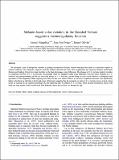Por favor, use este identificador para citar o enlazar a este item:
http://hdl.handle.net/10261/34046COMPARTIR / EXPORTAR:
 SHARE SHARE
 CORE
BASE CORE
BASE
|
|
| Visualizar otros formatos: MARC | Dublin Core | RDF | ORE | MODS | METS | DIDL | DATACITE | |

| Título: | Melanin-based color variation in the Bearded Vulture suggests a thermoregulatory function |
Autor: | Margalida, Antoni CSIC ORCID ; Negro, Juan J. CSIC ORCID ; Galván, Ismael CSIC ORCID | Palabras clave: | Bearded vulture Climate conditions Gypaetus barbatus Intraspecific variation Thermoregulatory role Bearded vulture Climate conditions Gypaetus barbatus |
Fecha de publicación: | 2008 | Editor: | Elsevier | Citación: | Comparative Biochemistry and Physiology - Part A: Molecular and Integrative Physiology 149(1): 87-91 (2008) | Resumen: | We document a case of intraspecific variation in plumage colouration in Bearded Vultures that may have arisen as a functional response to climate conditions. Two subspecies, Gypaetus We document a case of intraspecific variation in plumage colouration in Bearded Vultures that may have arisen as a functional response to climate conditions. Two subspecies, Gypaetus barbatus barbatus (Eurasia and North Africa populations) and Gypaetus barbatus meridionalis (Eastern and Southern Africa), have been described on the basis of plumage colour differences. The plumage of G. b. barbatus tends to be darker in comparison with that of G. b. meridionalis. The plumage of the two subspecies differ in the feathering of the tarsi (more abundant in G. b. barbatus) and presence/absence of dark ear tufts (only present in G. b. barbatus, and this being the most useful character to distinguish adult specimens of both subspecies). When exposing skins under the sun or to electric bulbs in a cold room, temperature increases were significantly higher in the black ear tufts than in the frontal region of the head, suggesting that the melanized ear patch of G. b. barbatus serves, at least, to heat up the air entering the ear channel and perhaps also the underlying skin. In addition, G. b. barbatus, which inhabits mountainous regions with harsh and long winters, would benefit more from feathered tarsi to prevent heat loss through the legsbarbatus barbatus (Eurasia and North Africa populations) and Gypaetus barbatus meridionalis (Eastern and Southern Africa), have been described on the basis of plumage colour differences. The plumage of G. b. barbatus tends to be darker in comparison with that of G. b. meridionalis. The plumage of the two subspecies differ in the feathering of the tarsi (more abundant in G. b. barbatus) and presence/absence of dark ear tufts (only present in G. b. barbatus, and this being the most useful character to distinguish adult specimens of both subspecies). When exposing skins under the sun or to electric bulbs in a cold room, temperature increases were significantly higher in the black ear tufts than in the frontal region of the head, suggesting that the melanized ear patch of G. b. barbatus serves, at least, to heat up the air entering the ear channel and perhaps also the underlying skin. In addition, G. b. barbatus, which inhabits mountainous regions with harsh and long winters, would benefit more from feathered tarsi to prevent heat loss through the legs. | Versión del editor: | http://dx.doi.org/10.1016/j.cbpa.2007.10.017 | URI: | http://hdl.handle.net/10261/34046 | DOI: | 10.1016/j.cbpa.2007.10.017 | ISSN: | 1095-6433 |
| Aparece en las colecciones: | (EBD) Artículos (IREC) Artículos |
Ficheros en este ítem:
| Fichero | Descripción | Tamaño | Formato | |
|---|---|---|---|---|
| melanifunction.pdf | 2,07 MB | Adobe PDF |  Visualizar/Abrir |
CORE Recommender
PubMed Central
Citations
6
checked on 21-abr-2024
SCOPUSTM
Citations
32
checked on 15-abr-2024
WEB OF SCIENCETM
Citations
27
checked on 24-feb-2024
Page view(s)
330
checked on 23-abr-2024
Download(s)
284
checked on 23-abr-2024
Google ScholarTM
Check
Altmetric
Altmetric
Artículos relacionados:
NOTA: Los ítems de Digital.CSIC están protegidos por copyright, con todos los derechos reservados, a menos que se indique lo contrario.
